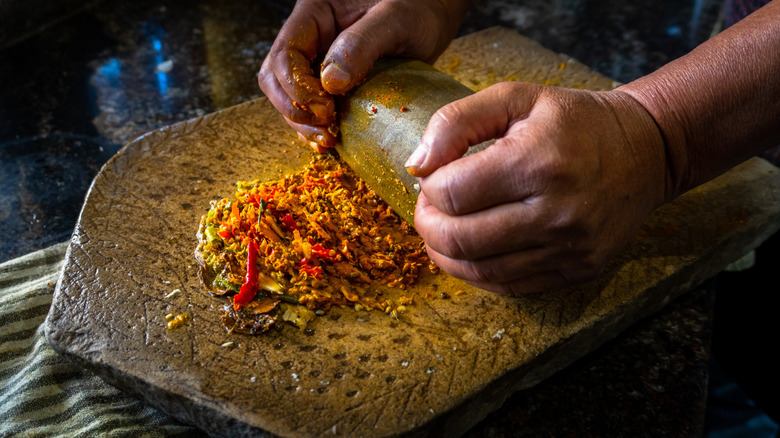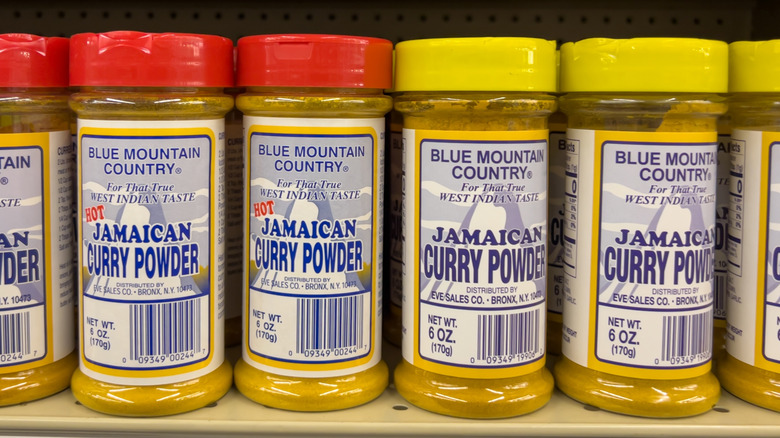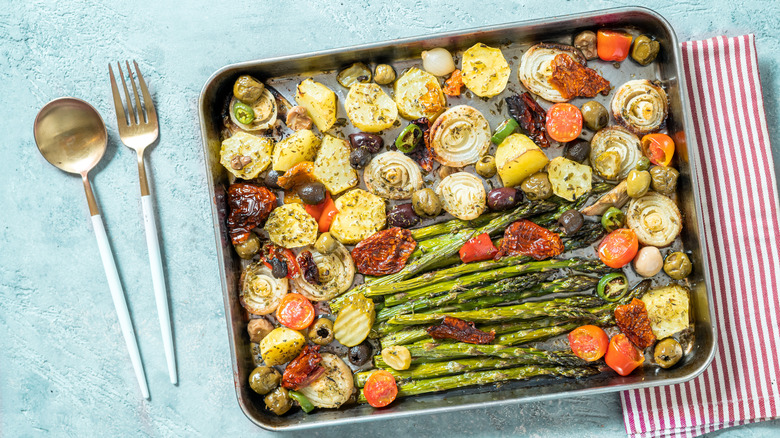Garam Masala Vs Curry Powder: Which One Should You Use?
We may receive a commission on purchases made from links.
If you're new to cooking Indian food, you might be confused about the difference between garam masala and curry powder. You might spend time browsing supermarket shelves wondering which one you should buy. Or perhaps you've assumed that these two spice blends are pretty much the same and can be used interchangeably. Either way, it's time to get to grips with this.
Garam masala is a staple North Indian cuisine. It's a blend of spices that goes in many dishes, from restaurant favorites such as butter chicken to dishes that are less common in the U.S. like vada pav. You might assume that curry powder's roots are similar, but it actually doesn't originate from India at all. While it has its place in the kitchen for many home cooks, it's not what everyone thinks it is.
We're about to discuss these differences and more in greater detail, as we pit garam masala and curry powder head-to-head. Which one you choose will impact the flavor profile of the dish you're making, so don't just reach for whichever you have in the pantry. Learning more about both these spice blends will improve your cooking and might help you get more creative.
Garam masala is an authentic Indian spice blend
Maybe you're still wondering, what is garam masala? Well, learning more about it is a great place to start. Without that knowledge, you'll never be able to grasp the difference between it and curry powder. Although the exact origins of garam masala are unclear, it's been used in Indian cooking — particularly North Indian — for centuries. So we can well and truly class it as an Indian spice blend.
That said, it's not just used in Indian cuisine. Over the years, its use has spread into neighboring countries. This is fairly common in non-island nations because strict borders between countries are a modern construct. You'll also find garam masala used in Pakistani, Bangladeshi, Nepalese, and Sri Lankan cuisines, plus in some Caribbean food.
"Garam" means warm or hot in Hindi, while "masala" is the word for a spice blend. It's generally taken to mean "warming spice blend," since the ingredients that make up garam masala are fragrant rather than hot. You'll find it in a wide range of authentic Indian dishes. In fact, it's the main spice blend used in Indian cuisine. Often, recipes call for garam masala in addition to other spices to change the flavor profile between dishes.
Curry powder is a British invention
Unlike garam masala, curry powder isn't actually used in India. So, what exactly is curry powder? Well, to start with, it's a British invention, not an authentic Indian spice mix. In India, cooks use many different spices to make their dishes. They mix these spices in different ways for each recipe. There's no one "curry powder" that goes into everything. If anything, it's garam masala that takes that role, but it's not really the same.
Ultimately, curry powder is a product of British colonialism. It was created in the 1800s when the Brits had invaded India and the country was considered part of the British empire. British people wanted an easy way to make Indian-style food at home, so they made a premixed spice blend and called it curry powder. This also led to the trend of calling a large portion of Indian food "curries." This isn't a term that's used in India at all. Rather, dishes will be referred to by their names, such as saag paneer or murgh makhani.
When you see curry powder in stores or recipes, remember it's not really Indian. It's a British shortcut to mimic Indian flavors. It's not that the spices used in curry powder aren't also used in Indian food. It's just that if you use curry powder for everything, your dishes will start to taste the same. Real Indian cooking is much more varied and complex in its use of spices, such as adding garam masala to a dish with additional spices.
There's no single recipe for either garam masala or curry powder
What can get a bit confusing about both garam masala and curry powder is that there isn't one set recipe for either of them. You'd expect to find the same blend of spices every time, but it can seem like there are as many variants of each one as there are varieties of curry. Usually, both curry powder and garam masala always contain a few core ingredients but the rest depends on the manufacturer (in the case of store-bought blends) or the individual making it.
Store-bought curry powder usually contains plenty of turmeric — which is what gives it that yellow hue — along with coriander, cumin, ginger, fenugreek, and chili. It may have other ingredients, such as cinnamon, cloves, and allspice. It sometimes also contains salt, garlic, and starches. The balance varies, so some curry powders might be fenugreek-forward, whereas others are heavy on the chili or fairly well balanced.
The core ingredients found in most garam masala recipes typically include cumin seeds, coriander seeds, cardamom, cinnamon, black peppercorns, and cloves. These spices form the backbone of most garam masala blends. However, there are regional and personal variations. You might also find nutmeg, mace, star anise, fennel seeds, or mustard seeds in garam masala. These ingredients are found in varying ratios, so no two versions are identical.
Garam masala is sweeter than curry powder, but also more pungent
Now you know that curry powder and garam masala contain different ingredients, it's clear they don't taste the same. But their ingredients do overlap in places, so how do they taste different?
Since garam masala usually has spices like cinnamon, cardamom, cloves, and cumin, it has a sweet, bright flavor. When you smell garam masala, you might clock into floral or mildly fruity notes. It adds warmth and complexity to dishes without being spicy. Curry powder is often heavy on the turmeric, which gives it not only a yellow color but an earthy smell and taste. It has a deeper, more savory flavor that some people describe as musty or woody. A lot of the savory notes come from fenugreek and turmeric.
Although it might sound like curry powder would be the stronger flavor, garam masala is often more vibrant and more pungent. It's punchier and cuts through the other flavors in a dish better. It doesn't help that curry powder often languishes in pantries for years, becoming less and less fragrant.
If you're not sure what you prefer, try using both in your cooking separately to see which you prefer. You might find you like the sweet brightness of garam masala in some dishes and the earthy richness of curry powder in others.
In Indian households, garam masala is traditionally made from scratch
What you might not know is that Indian families traditionally make garam masala from scratch at home. So it's not just something you buy at the store — it's a family tradition. Every household has its own recipe for garam masala. They might use different spices or change how much of each spice they use. This means the garam masala in one house might taste a bit different from the one next door.
When making garam masala from scratch, whole spices are toasted and then ground to a powder. This fresh, homemade blend tastes better than store-bought versions. Part of this is because ground spices soon lose many of the essential oils that give them their flavor. So, that musty old jar in your pantry can't compare to freshly ground spice blends used within a day or two.
However, things are changing in India today. Younger generations are busier and may not have time to make garam masala from scratch. More and more people, especially in cities, are buying pre-ground garam masala from stores. It's quicker and easier, even if it might not taste quite the same as homemade.
If you're looking to make something really special, consider making your own garam masala. Anyone who regularly cooks a variety of cuisines from scratch will probably already have all the whole spices they need. It might not be something you'd do everyday, but it's worth trying to experience garam masala at its best.
Garam masala isn't usually spicy, but curry powder can be
Garam masala is often described as warm and aromatic, but it isn't hot. As we've covered, it blends a combination of aromatic spices with notes that are fruity, smoky, piney, sweet, and even grassy. The combination can be warming in the way ginger or cinnamon alone might be, but none of these spices bring any significant amount of heat. Some may find black pepper that's sometimes in garam masala a little spicy, but it isn't hot in the same way as chili is.
Curry powder, on the other hand, often contains chilies in some quantity. You'll often find that it's described as mild, medium, or hot. Mild curry powder either forgoes chili peppers or contains just a small amount. Enough to bring a tiny bit of heat to dishes but not enough to be classified as truly spicy. Medium curry powders are a little spicy, while hot ones are significantly spicy. The great thing about this is that you can choose which one works for you based on your preferences and spice tolerance.
If you're looking for just one spice blend to bring heat to your dishes, then a hot curry powder might be the answer. However, you shouldn't write off garam masala. It's often used in dishes that contain fresh chilies, so these bring the heat while the spice blend brings aromatic flavors.
There are various types of curry powder
Although manufacturers and individuals all have their own blend, there's still technically only one garam masala. Each iteration may taste slightly different, but you can use it in any recipe that calls for garam masala with broadly similar results. Curry powder, on the other hand, is available in a range of varieties. We've already covered mild, medium, and hot variations, but it goes beyond that.
For starters, there's Jamaican curry powder, which is commonly found in large supermarkets. It differs from Indian curry powder by leaning into more traditionally Caribbean flavors, such as allspice, cloves, cinnamon, and nutmeg. Unlike curry powder, which isn't really used in authentic Indian recipes, it's a key ingredient in Jamaican curries.
There's also Madras curry powder, which is especially hot and focuses on a blend of spices typical of the Madras region of India. Other curry powders include Thai curry powder — which gives you a taste of Thai spices but isn't genuinely used in Thai cuisine — and Japanese curry powder, which is used for katsu curry.
Curry powder is more commonly used in Western-style Indian food
Curry powder might make you think of Indian food, but as we now know, it's nowhere to be found in traditional Indian cooking. Instead, people use curry powder more often in Western countries like the United States and the United Kingdom when they want to make easy Indian-inspired dishes.
The British invented curry powder when they colonized India to easily make Indian "curries" without using a lot of separate spices. When they brought this spice mix back home, it became popular in British cooking. Later, curry powder spread to other countries like the U.S. and around mainland Europe. Curry powder has such a long history in the U.K. that it appeared in several recipes in "Mrs Beeton's Book of Household Management," which was published way back in 1861. The book specifies that, at this time, that premixed curry powder would have been available in any "respectable shop."
Today, people in the U.K. and U.S. still make generic curries using curry powder. If you've ever made something like a chickpea and spinach curry rather than chana masala or a chicken curry rather than a chicken dhansak, it is likely that the recipe called for curry powder. It's also used in other Indian-inspired dishes such as Mulligatawny soup and coronation chicken.
Garam masala is used in a huge number of traditional Indian recipes
While curry powder is only used in Indian-inspired recipes, garam masala is an ingredient in many traditional Indian recipes. In fact, there are thousands of Indian recipes that call for garam masala. You'll find it in the classic Punjabi dish pindi chole, featuring richly spiced chickpeas. It's also in bhindi masala, an okra dish with a rich gravy. And garam masala even plays a role in restaurant-style paneer butter masala. But this is just the tip of the iceberg. If you want to make authentic Indian dishes, you must have garam masala.
If you're making an Indian recipe that calls for this spice blend and you don't have any on hand, you might be wondering what you can substitute for garam masala. If you cook a lot of Indian dishes, you might have chaat masala in your pantry. This is another Indian spice blend that's loosely similar. However, your best bet is making your own from whole spices. Since there are so many variations, you're sure to find one that you can make with what you have.
You can use both curry powder and garam masala for various dishes beyond curries
You might assume that garam masala and curry powder are only good for curries and other similar dishes. However, there's a huge number of other recipes that call for these ingredients. Or, you can experiment with various places to use these spice blends. Curry powder can go in everything from salad to lasagna to grits. Similarly, garam masala's uses are broader than you might think — you can even bake with it.
If you're not looking to follow a recipe exactly, there are plenty of creative ways you can use either curry powder or garam masala. Try tossing veggies in one of these spice blends before roasting them. You can then stuff the vegetables in pitas or eat them over rice with a drizzle of tahini sauce. Looking for new ways to spice up your fries? Garam masala and curry powder are both up to the job. They're also delicious in soups, particularly balancing out sweet ingredients, such as butternut squash or sweet potatoes. You can also use these blends to spice up a boring stew or to add a warming, aromatic twist to flatbreads.
Garam masala and curry powder are both readily available
Ingredient availability matters. It can be annoying when a chef or food writer touts their favorite spice blend or other ingredient, but you can't find it anywhere. Not everybody has access to a variety of international markets or boutique food shops, meaning they can miss out. However, you might be pleased to know that garam masala and curry powder are both readily available.
You'll generally find both of these spice blends at even small to mid-sized supermarkets. Usually, they're just in with the other herbs and spices. However, at some grocery stores, you might find them next to other ingredients commonly used in Indian cuisine, such as curry pastes, ghee, coconut milk, and big bags of chickpeas and lentils. Even if you need to check a couple of sections, the good news is, you can most likely find both when you pick up your regular weekly shop. Curry powder may be moderately easier to get hold of, even showing up in some tiny neighborhood grocery stores, but garam masala isn't far behind.
Should you use garam masala or curry powder?
Now that you know more about both these spice blends it's time to figure out whether garam masala or curry powder is right for you. This really depends on what you want from a spice blend and what you're looking to cook.
If you want to make authentic Indian recipes, garam masala is your best bet. So many Indian dishes call for this blend, along with other spices, so you'll often find yourself reaching for it. However, you might be looking to replicate the more generic curry flavor that your parents made growing up. In which case, the earthy flavor and yellow turmeric-heavy hue of curry powder might be what you're after. Or, perhaps you want to make Caribbean curries, in which case, you should be looking for Jamaican curry powder.
Still not sure? Check some recipes that you're interested in making and see what they call for. Ultimately, you might want both garam masala and curry powder in your pantry to use in different recipes.












